
French Vocabulary Audio Clip He was a French Explorer
- Subject:
- Arts and Humanities
- Languages
- Material Type:
- Interactive
- Provider:
- Michigan Virtual
- Date Added:
- 02/04/2020

French Vocabulary Audio Clip He was a French Explorer

French Vocabulary Audio Clip She was a French Writer

French Vocabulary Audio Clip He was a French Writer
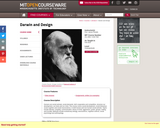
Humans are social animals; social demands, both cooperative and competitive, structure our development, our brain and our mind. This course covers social development, social behaviour, social cognition and social neuroscience, in both human and non-human social animals. Topics include altruism, empathy, communication, theory of mind, aggression, power, groups, mating, and morality. Methods include evolutionary biology, neuroscience, cognitive science, social psychology and anthropology.
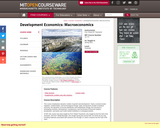
This course emphasizes dynamic models of growth and development. Topics covered include: migration, modernization, and technological change; static and dynamic models of political economy; the dynamics of income distribution and institutional change; firm structure in developing countries; development, transparency, and functioning of financial markets; privatization; and banks and credit market institutions in emerging markets.
At MIT, this course was team taught by Prof. Robert Townsend, who taught for the first half of the semester, and Prof. Abhijit Banerjee, who taught during the second half. On OCW we are only including materials associated with sessions one through 13, which comprise the first half of the class.

Seminar on downtown in US cities from the late nineteenth century to the late twentieth. Emphasis on downtown as an idea, place, and cluster of interests, on the changing character of downtown, and on recent efforts to rebuild it. Subjects considered include subways, skyscrapers, highways, urban renewal, and retail centers. Focus on readings, discussions, and individual research projects. Meets with graduate subject 11.339, but assignments differ.
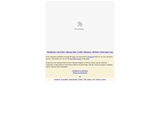
is a travel itinerary that highlights 45 historic places that help tell the story of Spanish colonization of California. Learn about forts, churches, adobe houses, historic districts, and other places. Find out about the Presidio, which was established in 1769 as the base for Spain's colonization efforts and was the first permanent European settlement on the Pacific Coast.
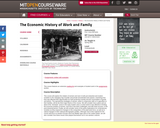
Explores the changing map of the public and the private in pre-industrial and modern societies and examines how that map affected men's and women's production and consumption of goods and leisure. The reproductive strategies of women, either in conjunction with or in opposition to their families, is another major theme. How did an ideal of the "domestic" arise in the early modern west, and to what extent did it limit the economic position of women? How has it been challenged, and with what success, in the post-industrial period? Focuses on western Europe since the Middle Ages and on the United States, but some attention to how these issues have played themselves out in non-Western cultures. This course will explore the relation of women and men in both pre-industrial and modern societies to the changing map of public and private (household) work spaces, examining how that map affected their opportunities for both productive activity and the consumption of goods and leisure. The reproductive strategies of women, either in conjunction with or in opposition to their families, will be the third major theme of the course. We will consider how a place and an ideal of the "domestic" arose in the early modern west, to what extent it was effective in limiting the economic position of women, and how it has been challenged, and with what success, in the post-industrial period. Finally, we will consider some of the policy implications for contemporary societies as they respond to changes in the composition of the paid work force, as well as to radical changes in their national demographic profiles. Although most of the material for the course will focus on western Europe since the Middle Ages and on the United States, we will also consider how these issues have played themselves out in non-western cultures.
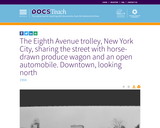
The Eighth Avenue trolley, New York City, sharing the street with horse-drawn produce wagon and an open automobile. Downtown, looking north (1904)
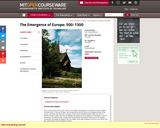
Survey of the social, cultural, and political development of western Europe between 500 and 1300. Topics include: the Germanic conquest of the ancient Mediterranean world; the Carolingian Renaissance; feudalism and the breakdown of political order; the crusades; the quality of religious life; the experience of women; and the emergence of a revitalized economy and culture in the twelfth and thirteenth centuries.
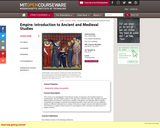
This course is an investigation of the Roman empire of Augustus, the Frankish empire of Charlemagne, and the English empire in the age of the Hundred Years War. Students examine different types of evidence, read across a variety of disciplines, and develop skills to identify continuities and changes in ancient and medieval societies. Each term this course is different, looking at different materials from a variety of domains to explore ancient and mideveal studies. This version is a capture of the course as it was taught in 2012, and does not reflect how it is taught currently.
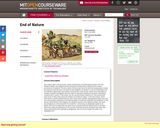
A brief history of conflicting ideas about mankind's relation to the natural environment as exemplified in works of poetry, fiction, and discursive argument from ancient times to the present. What is the overall character of the natural world? Is mankind's relation to it one of stewardship and care, or of hostility and exploitation? Readings include Aristotle, The Book of Genesis, Shakespeare, Descartes, Robinson Crusoe, Swift, Rousseau, Wordsworth, Darwin, Thoreau, Faulkner, and Lovelock's Gaia. This subject offers a broad survey of texts (both literary and philosophical) drawn from the Western tradition and selected to trace the growth of ideas about nature and the natural environment of mankind. The term nature in this context has to do with the varying ways in which the physical world has been conceived as the habitation of mankind, a source of imperatives for the collective organization and conduct of human life. In this sense, nature is less the object of complex scientific investigation than the object of individual experience and direct observation. Using the term "nature" in this sense, we can say that modern reference to "the environment" owes much to three ideas about the relation of mankind to nature. In the first of these, which harks back to ancient medical theories and notions about weather, geographical nature was seen as a neutral agency affecting or transforming agent of mankind's character and institutions. In the second, which derives from religious and classical sources in the Western tradition, the earth was designed as a fit environment for mankind or, at the least, as adequately suited for its abode, and civic or political life was taken to be consonant with the natural world. In the third, which also makes its appearance in the ancient world but becomes important only much later, nature and mankind are regarded as antagonists, and one must conquer the other or be subjugated by it.
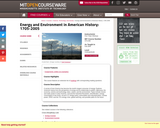
A survey of how America has become the world's largest consumer of energy. Explores American history from the perspective of energy and its relationship to politics, diplomacy, the economy, science and technology, labor, culture, and the environment. Topics include muscle and water power in early America, coal and the Industrial Revolution, electrification, energy consumption in the home, oil and US foreign policy, automobiles and suburbanization, nuclear power, OPEC and the 70's energy crisis, global warming, and possible paths for the future.
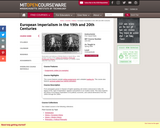
From pineapples grown in Hawai'i to English-speaking call centers outsourced to India, the legacy of the "Age of Imperialism" appears everywhere in our modern world. This class explores the history of European imperialism in its political, economic, and cultural dimensions from the 1840s through the 1960s.
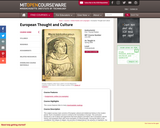
This subject surveys main currents of European cultural and intellectual history in the modern period. Such a foundation course is central to the humanities in Europe. The curriculum introduces a set of ideas and arguments that have played a formative role in European cultural history, and acquaints them with some exemplars of critical thought. Among the topics to be considered: the critique of religion, the promise of independence, the advance of capitalism, the temptations of Marxism, the origins of totalitarianism, and the dialects of enlightenment. In addition to texts, we will also discuss pieces of art, incl. paintings and film.

French vocabulary note cards on school subjects
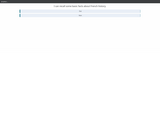
Can-Do Statement about French Historical Leaders
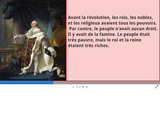
French Revolution Slide Presentation
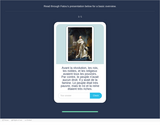
Short Paragraph about Pre-Revolutionary French Nobility

French History Multiple Choice Quiz